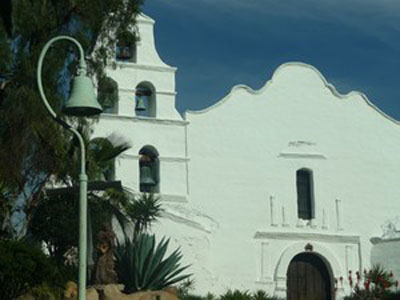
By Donald H. Harrison

SAN DIEGO—It is not uncommon on Saturdays at Mission San Diego to find a bride posing at the landmark bell tower – two romantic images in white.
“Whenever they established a mission, they would put a cross in the ground, and some kind of bell, and dedicate the mission to a specific saint,” chief docent Janet Bartel tells visitors.
“We tell kids (who visit the mission as part of their fourth-grade California history studies) that the bell tower (known as a campanario) was their clock basically. They knew when to get up in the morning, and when they were being called to lunch. You could tell by the intonation and the peal of the bell whether it was somber for a funeral or happy for a wedding.”
A sign in the mission’s interior courtyard elaborates that “a sequence of tones and rhythms was developed for each occasion. They were used to announce times for Mass, work, meals, siestas.”
The sign also tells stories of two of the bells: “The crown-topped bell on the lower right is named the Ave Maria Purisima—Immaculate Mary. It weighs 805 pounds and was cast in 1801. A crown-topped bell was usually supplied by the Spanish king and cast in the royal foundry in Barcelona at the King’s expense or made in a country ruled by Spain. Ave Maria Purisima was in the vestibule of St. Joseph’s church and was hung in the campanario after the reconstruction of Mission San Diego in 1931.
“The bell on the lower left is called Mata Dolorosa – Our Lady of Sorrows. It weighs 1200 pounds and was recast by the Standard Iron Works in San Diego in 1894 from bell fragments found in the vicinity of the mission.”
When all 21 California missions were built, each was located about 30 miles from the other—approximately a one-day distance by horse. The trail connecting them has become known as “El Camino Real” – the King’s Road.
A stand-alone bell was located approximately one mile from the mission, and another was placed two miles from the mission, Bartel said. In the late 18th and early 19th centuries when a Franciscan rang the two-mile bell, it could be heard at the mission. Today, of course, the sounds of bells carry only a fraction of that distance, because they are drowned out by the sound of cars on nearby roads and freeways.
A tug on the two-mile bell “was telling the Franciscans here that ‘we are going to have company,’ So they got the food going, and the bed ready because they knew that the travelers would be tired,” Bartel said.
Bells were prominent in the architecture of each of the missions, and most especially at Mission San Diego, where five bells are housed in the 46-foot high campanario.
In the late 19th and early 20th century, California boosters—in large measure financed by the railroads, which sought to spur tourism–helped to romanticize the Golden State’s Spanish and Mexican periods.
Stories of Spanish dons, beautiful senoritas dancing the fandango, talented horsemen and wise and kindly Padres living in an era of chivalry, grace, and courtliness were the staples of fiction. These legends subsequently were encapsulated in the movies and television series about “Zorro,” a fictional, masked, ever-so-charming, Robin-Hood-style swordsman.
In the early 20th century, women’s clubs began a campaign to place mission bells on tall shepherd’s staffs somewhat along the route of the old El Camino Real. Boosters sought to secure for every town along the way at least one, and in some cases several, of the charming symbols. Several of them line the driveway to Mission San Diego, providing the juxtaposition of the bells of El Camino Real with the mission bills.
Besides invoking California’s romanticized past, the bells of El Camino Real originally had small plaques telling distances to the next town or important landmark. Unfortunately, over the years, many of the bells were vandalized or stolen for souvenirs. They have been replaced, without clappers, along such public rights-of-way as the freeways.
*
Harrison is editor of San Diego Jewish World. This article previously was published on examiner.com